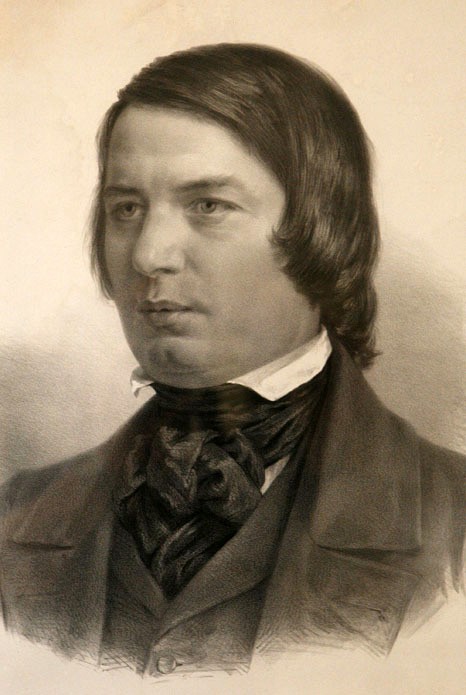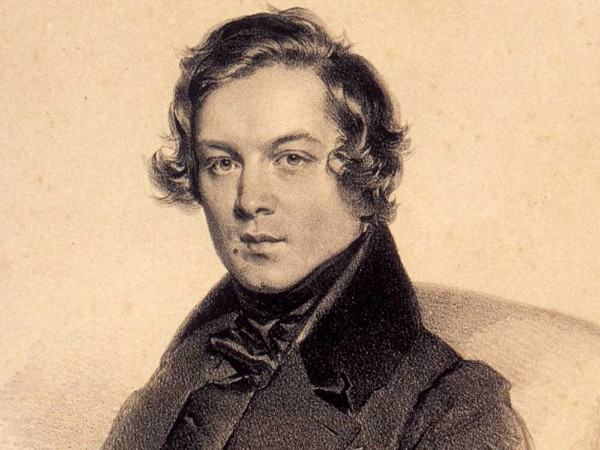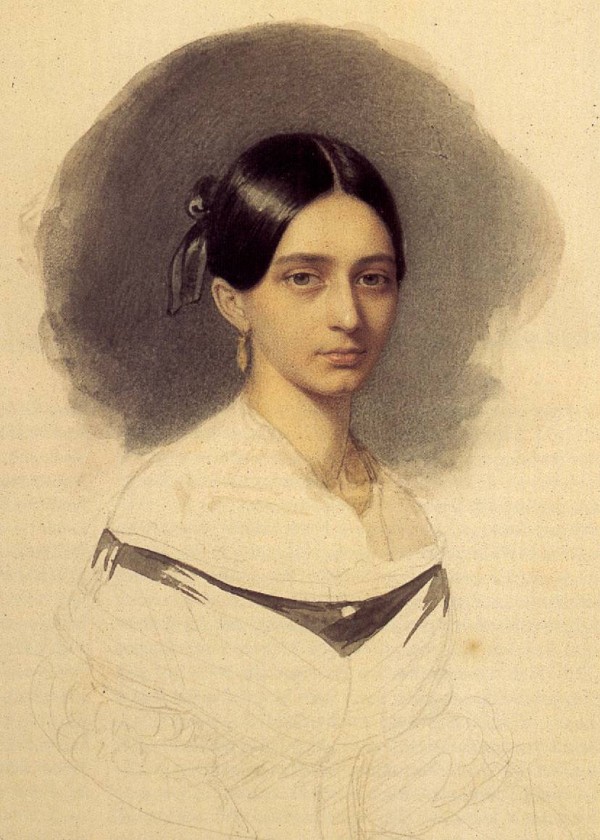In the vast regions of musical forms, there lurks a quiet yet evocative gem, often overlooked in favour of grander symphonies or intricate sonatas. The “Albumblatt,” literally translated as “album leaf”, tends to be a short and intimate composition, typically for piano, that captures a fleeting mood, memory, or impression.
The Albumblatt evokes the idea of a musical page in an album, akin to a brief, sentimental entry in a scrapbook or autograph book. While not considered a distinct musical genre with rigid rules, Albumblatt is a descriptive title to denote a piece that is light, expressive, and often written as a personal dedication or gift to friends, patrons, or loved ones.
Albumblatt

Portrait of Robert Schumann
Its origins trace back to the 19th century, when composers sought to infuse their music with personal expression and poetic nuance. These musical keepsakes were cherished for their ability to convey profound sentiment within a compact frame, much like a pressed flower preserving a moment in time.
The charm of the Albumblatt lies in its simplicity and versatility, serving as a canvas for composers to experiment with lyrical melodies and delicate harmonies. Unlike the rigid structures of classical forms, the Albumblatt embraced freedom, inviting composers to weave narratives or emotions without the constraints of formal development.
Unpublished Gems
These tender offerings allowed masters like Robert Schumann to distill their artistry into brief and heartfelt statements. Nestled among his evocative piano works, Schumann crafted a number of these miniatures with a blend of poetic lyricism and introspective depth.
Schumann started to compile a special collection of 20 pieces he eventually published as his Albumblätter, Op. 124, around Christmas in 1850. He had just moved to Düsseldorf to take up the position as music director, and to actively pass the time, he reviewed and put into order as yet unpublished piano pieces from the previous twenty years.
Chaff
As a scholar writes, “at first glance, the collection appears to be quite haphazard. Yet, of all Schumann’s works for piano, the collection fascinatingly combines flashes of brilliant genius by the young Schumann with those of the mature composer.”
Offering the selection of pieces to the publisher Friedrich Wilhelm Arnold, Schumann writes, “While putting the older of my scores in order, I ran across quite a few pieces for piano which I would be interested in having published as a collection entitled ‘Chaff.’”
Bunte Blätter

Robert Schumann
The publisher was horrified by the title suggestion and tried to suggest that instead of “Chaff”, the title might read “Among the sheaves,” for “what is left lying between the sheaves are still heads of grain. Schumann agreed and these pieces eventually received the title Bunte Blätter (Leaves of Many Colours).
Since short piano pieces by Schumann were in high demand, Schumann also set to work on compiling the Albumblätter. In the end, Schumann published this collection of 20 works comprising Opus 124. Some of the miniatures had originally been intended for inclusion in the Papillons, Kinderszenen, and Carnaval sets, but had initially been rejected.
Poetic Depth
The set reflects Schumann’s Romantic ideals as we find a preference for poetic expression, miniature forms, and emotional depth. Each piece is relatively brief, and typically lasts one to two minutes, with a total duration of about 28 minutes for the entire set. The collection is technically accessible for intermediate to advanced pianists.
Robert Schumann: Albumblätter, Op. 124, No. 1 “Impromptu” (Peter Frankl, piano)
Impromptu
Composed in the early 1830s, the opening “Impromptu” sets a lively and exuberant tone, reflecting Schumann’s youthful exuberance. It is a spirited dance-like piece with a flowing melody over a syncopated accompaniment. The bright C-major tonality and rhythmic vitality suggest a carefree mood.
Robert Schumann: Albumblätter, Op. 124, No. 2 “Leides Ahnung” (Foreboding of Sorrow) (Peter Frankl, piano)
Leides Ahnung (Foreboding of Sorrow)

Clara Wieck Schumann
This gem likely originated during Schumann’s emotionally turbulent time in the 1830s, possibly reflecting his struggles with career and love. It is a melancholic and introspective miniature, with the key of A minor creating a sense of unease, enhanced by subtle dynamic shifts.
Robert Schumann: Albumblätter, Op. 124, No. 3 “Scherzino” (Peter Frankl, piano)
Scherzino
This short and whimsical scherzo likely dates from the mid-1830s and features a skipping rhythm cast in a bright F-major tonality. Cast in ternary form, it includes a contrasting middle section in the minor key, adding a touch of drama before returning to the cheerful main theme.
Robert Schumann: Albumblätter, Op. 124, No. 4 “Walzer” (Peter Frankl, piano)
Waltz
Likely composed in the late 1830s, this waltz aligns with Schumann’s fascination with dance forms. It is graceful yet slightly melancholic as Schumann selected a D-minor key. The melody is elegant but tinged with longing, while its brevity keeps it intimate.
Robert Schumann: Albumblätter, Op. 124, No. 5 “Phantasietanz” (Peter Frankl, piano)
Phantasietanz
This “Fantasy Dance” reflects Schumann’s imaginative approach to dance-inspired works. Cast in a major key, this lively and energetic dance unfolds at a breakneck speed, and the syncopated rhythms create a sense of spontaneity. The contrasting middle section introduces a lyrical interlude.
Robert Schumann: Albumblätter, Op. 124, No. 6 “Wiegenliedchen” (Peter Frankl, piano)
Wiegenliedchen

Robert Schumann
This tender “Little Lullaby” probably dates from the early 1840s, possibly inspired by Schumann’s new role as a father. It features a gentle and soothing melody over a rocking accompaniment, and the G-major tonality and soft dynamics evoke warmth and tranquillity.
Robert Schumann: Albumblätter, Op. 124, No. 7 “Ländler” (Peter Frankl, piano)
Ländler
A character pieces styled as a “Ländler,” this gem features a triple-meter dance with a relaxed and pastoral quality. Capturing the Ländler’s rustic charm, it still retains Schumann’s lyrical refinement, evoking a sense of nostalgia or pastoral simplicity. An appealing piece for pianists, its emotional subtlety rewards careful interpretation.
Robert Schumann: Albumblätter, Op. 124, No. 8 “Lied ohne Ende” (Peter Frankl, piano)
Lied ohne Ende
“Song without End”, dates from 1837, is a lyrical miniature evoking a sense of continuous melody, as suggested by its title. Lacking a definitive conclusion, Schumann created an open-ended and reflective mood. Cast in a simple ternary structure, the central melodic idea recurs and evolves subtly.
Robert Schumann: Albumblätter, Op. 124, No. 9 “Impromptu” (Peter Frankl, piano)
Impromptu
This “Impromptu” is a compact character piece with a central thematic idea that evolves through subtle variations and contrasts. The lyrical and introspective melody features a vocal quality that actually recalls Schumann’s lieder. Balancing spontaneity with subtle melancholy, the pieces embody Schumann’s aesthetic of music as poetry.
Robert Schumann: Albumblätter, Op. 124, No. 10 “Walzer” (Peter Frankl, piano)
Walzer
Likely composed around 1837, this “Waltz” reflects Schumann’s poetic expression and emotional nuance. The graceful and lyrical melody captures the waltz’s elegance and carries a gentle, almost nostalgic charm. To be sure, gentle rubatos and dynamic contrasts evoke a ballroom atmosphere.
Robert Schumann: Albumblätter, Op. 124, No. 11 “Romanze” (Peter Frankl, piano)
Romanze

Robert and Clara Schumann
A concise and evocative miniature, the “Romanze” is a lyrical character piece evoking a sense of intimacy and nostalgia. This gem demands a warm and expressive performance, with careful attention to legato phrasing and dynamic nuances conveying its heartfelt mood.
Robert Schumann: Albumblätter, Op. 124, No. 12 “Burla” (Peter Frankl, piano)
Burla
A spirited piece with a playful, almost impish character, the “Burla,” meaning jest or prank, confirms its title. The G minor key and fast tempo drive its energetic melody, with sudden dynamic shifts adding a sense of fun.
Robert Schumann: Albumblätter, Op. 124, No. 13 “Larghetto” (Peter Frankl, piano)
Larghetto
A reflective piece from the 1830s, the “Larghetto” aligns with Schumann’s lyrical side. It features a slow and meditative melody over a rich accompaniment, with the major tonality lending warmth. The deliberate tempo allows for expressive phrasing, making it one of the set’s more introspective moments.
Robert Schumann: Albumblätter, Op. 124, No. 14 “Vision” (Peter Frankl, piano)
Vision
The title suggests a dreamlike or imaginative quality, and “Vision” is a delicate and ethereal piece with a soft, flowing melody in C Major. The pedal and gentle arpeggios create a hazy, otherworldly atmosphere, evoking a fleeting vision or reverie.
Robert Schumann: Albumblätter, Op. 124, No. 15 “Walzer” (Peter Frankl, piano)
Walzer
Another waltz, likely dating from the late 1830s, this miniature has a darker and more introspective side. A brooding and elegant waltz in the minor key, the haunting melody and restrained dynamics create a sense of melancholy.
Robert Schumann: Albumblätter, Op. 124, No. 16 “Schlummerlied” (Peter Frankl, piano)
Schlummerlied

Robert Schumann: Albumblätter, Op. 124, No. 17 “Elfe”
Possibly inspired by Schumann’s domestic life in the early 1840s, the “Slumber Song” is a peaceful and lyrical work casting a soothing melody over a gently rocking accompaniment. The major tonality and soft dynamics certainly create a dreamlike atmosphere.
Robert Schumann: Albumblätter, Op. 124, No. 17 “Elfe” (Peter Frankl, piano)
Elfe
The title “Elf” evokes the whimsical and fantastical imagery common in Romantic music. A sparkling and delicate piece with a rapid and fluttering melody, it is light in texture and quick in tempo. Suggesting the fleeting movement of an elf, the playful dynamic shifts add to its charm.
Robert Schumann: Albumblätter, Op. 124, No. 18 “Botschaft” (Peter Frankl, piano)
Botschaft
“Message” suggests a communicative or evocative intent, aligning with Schumann’s emphasis on music as a vehicle for personal expression. It likely originates from the early 1840s and reflects Schumann’s ability to capture fleeting emotions in concise forms.
Robert Schumann: Albumblätter, Op. 124, No. 19 “Phantasiestück” (Peter Frankl, piano)
Phantasiestück
The compelling character piece meaning “Fantasy Piece”, dates from the 1830s. It serves as a dynamic statement, and the key of G minor is frequently used by Schumann for intense, passionate, or stormy expressions. It certainly evokes a sense of urgency and drama, suggesting an imaginative or capricious narrative.
Canon
The concluding “Canon” in D minor showcases Schumann’s contrapuntal skill. The minor key gives it a sombre and processional quality, with overlapping voices creating a hypnotic effect.
Schumann’s Albumblätter Op. 124, composed over a decade, showcases his skill in crafting emotionally rich miniatures. This eclectic set reflects Schumann’s Romantic versatility, and its technical accessibility and expressive depth make it pedagogically valuable. Clara Schumann thought highly of this collection, and the diverse, curated pieces—playful, melancholic, and vigorous—offer a poetic glimpse into Schumann’s evolving creative life.
For more of the best in classical music, sign up for our E-Newsletter
Robert Schumann: Albumblätter, Op. 124, No. 20 “Canon” (Peter Frankl, piano)

